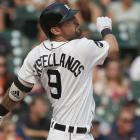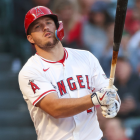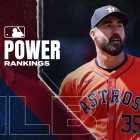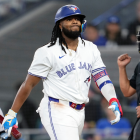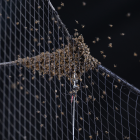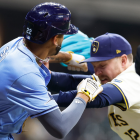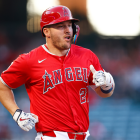As shrewd as general managers can be, they're ultimately beholden to the whims of their boss. If a baseball team's owner decides to go in a certain direction, that's the final word.
So it was, for many years, with the Tigers. They won four straight division titles from 2011 through 2014, but never went all the way, their one World Series appearance in that stretch resulting in an ignominious four-game sweep. The team's octogenarian owner Mike Ilitch, to his credit, kept investing in the product, determined to bring a championship to Detroit. Unfortunately, several of the moves the Tigers made in that quest were overreaches, on multiple occasions by Ilitch's hand.
Outbidding the market by a country mile to hand Prince Fielder $214 million was merely the most egregious example of Ilitch and the Tigers overextending themselves. Victor Martinez on a four-year, $68 million extension was a bad idea. Jordan Zimmermann for five years, $110 million was a terrible idea. Even re-upping franchise player and future Hall of Famer Miguel Cabrera was a whiff of gigantic proportions. It's not just that Cabrera has struggled with injuries and nosediving performance in his mid-30s. It's that the Tigers felt the need to hand him a deal for a quarter-billion dollars when he still had two years left on his existing contract, a move that looked like a historically bad reach the moment it happened.
- 2018 Result: 64-98, third place in AL Central
- Key free agents: Jose Iglesias, Francisco Liriano, James McCann
- Needs: Shortstop, outfield, catcher
Much has happened since then. Mike Ilitch passed away in February 2017, leaving his son Chris to take over the team. The team's payroll went from nearly $200 million that year to a projected $106 million for the coming season, per Cot's Baseball Contracts. Martinez retired, Fielder is long gone, and Justin Verlander, Justin Upton, J.D. Martinez, and Anibal Sanchez, all eight-figure-a-year players, have also moved on. Though Zimmermann is signed for two more years and Cabrera signed until the sun explodes, the rest of the roster is nearly a blank slate, allowing the Tigers to focus on accumulating young talent in the hopes of one day returning to the top of the AL Central.
That process is well underway. Headlining the Tigers system is a pair of exciting right-handers. Casey Mize was the first overall selection in last summer's draft, with a wicked fastball-slider-splitter repertoire that suggests ace-level potential. Twenty-year-old Matt Manning grades a bit behind Mize in terms of raw stuff, but there's no denying his results: The 2016 first-round pick surged through three levels before ending the 2018 campaign at Double-A, in the process fanning 154 batters in 117 2/3 innings.
Do you like athletic outfielders? Toolsy Daz Cameron actually improved upon promotion to Double-A last season, and just needs to refine his pitch selection a bit to give himself a chance to crack the Tigers' lineup by the end of next season. Do you like underrated shortstop prospects? Trading middling outfielder Leonys Martin for Willi Castro could be a steal, given Castro's speed, strong arm, and decent power (his .324/.366/.562 line at Double-A Erie was helped by some hit luck and a small 26-game sample size, though). There's also plenty of pitching depth in the system beyond the big two of Mize and Manning.
As with any rebuilding team, the Tigers must figure out which players (if any) on the current major league roster stand a chance of being quality major leaguers by the time they're good again.
Michael Fulmer would seem the most obvious candidate, at first glance anyway. The right-handed won AL Rookie of the Year honors in 2016, and had his own high-in-the-draft pedigree (44th overall in 2011) to suggest further optimism. But Fulmer's never been a big strikeout pitcher even at his best, and he's been discussed as trade bait from nearly the moment he accepted his award. Fulmer's inability to stay healthy for a full season, combined with those modest strikeout rates plus some home-run troubles in 2018, suggest that the Tigers likely won't get what they once hoped if they do trade him.
Though left-hander Matthew Boyd offers the same amount of controllable service time (four seasons), he looks like more of a potential keeper. Boyd mowed down hitters with a sub-3.00 ERA through the first two months of 2018, before imploding in June. But he misses more bats than Fulmer does, and his flyball-heavy balls-in-play results often play to his advantage at spacious Comerica Park.
The Tiger to watch this winter is Nick Castellanos. After a sluggish first two major league seasons, Castellanos has been a plus hitter since opening day 2016, batting .285/.336/.495 across nearly 1,800 plate appearances. Still, this is the perfect time for Detroit to sell. For one thing, Castellanos improved to a career-best .298/.354/.500 last season, a mark 30 percent better than league average on a park-adjusted basis. But he's also a year away from hitting the open market, and plays lousy defense.
The question is what the Tigers could get in return. Is there a team out there that will pay up for a good-to-very-good hitter who stunk at third base, got moved to right field, and stunk there too? An AL contender with a hole at DH and an occasional stomach for superutility work could make the most sense; the Rays could be a fit there, though not many other AL teams carry that profile.
The larger existential question is what the American League will look like three years from now. This winter, you've got the Orioles, Blue Jays, White Sox, Royals, Mariners and Rangers joining the Tigers as teams in some stage of a rebuild. Not all of these teams are going to be great -- look no further than the Reds for an example of a ballclub that's tried to rebuild for a long time without anything to show for it.
That means the Tigers, like their rebuilding AL rivals, will have to hit some home runs when it comes to player acquisition. They'll need to make the perfect trade at the perfect time, like the then-rebuilding Cubs did when they flipped Andrew Cashner for Anthony Rizzo. They'll need to have an undervalued prospect blossom into a star, the way the ascendant Astros did with Jose Altuve.
Call it smarts, call it luck, or a combination of both. When half the league decides to rebuild at once, you'd better nail all the little details, or risk floundering through a decade of irrelevance.
Jonah on the MLB offseason
NL East
Braves: May be offseason's most compelling team
Marlins: Finding where to send Realmuto
Mets: How Mets could jumpstart BVW era
Phillies: Harper or Machado might not be enough
Nationals: What will the Nats do if Harper leaves?
NL Central
Cubs: Keys to a Cubs rebound in 2019
Reds: Can Cincy revamp its pitching staff?
Brewers: Why Milwaukee should dig deeper in its war chest
Pirates: How Buccos can get aggressive
Cardinals: St. Louis can close the NL Central gap
NL West
Diamondbacks: How drastic will the rebuild be?
Rockies: Colorado needs bats to match pitching staff
Dodgers: How L.A. can spend big this winter
Padres: San Diego is the biggest mystery team of the offseason
Giants: Trading MadBum and others makes sense
AL East
Orioles: Nowhere to go but up for new O's leadership
Red Sox: Active offseason could lead to World Series repeat
Yankees: Machado fits Yanks' wants and needs
Rays: Tampa in position for unusually aggressive winter
Blue Jays: Toronto needs to embrace rebuild
AL Central
White Sox: Compelling dark horse in Harper, Machado races
Cleveland: Why a Kluber or Bauer blockbuster makes sense













